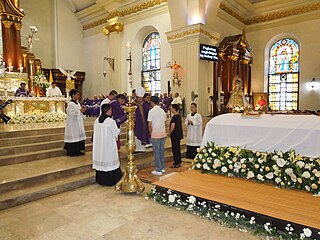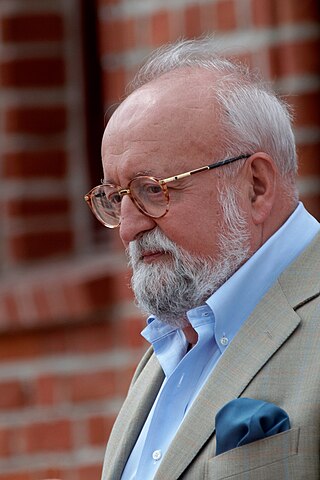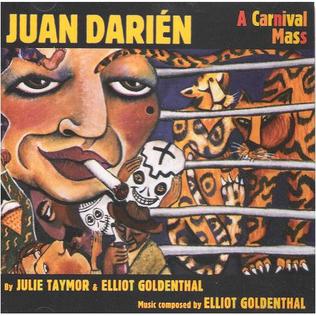Lacrimosa is part of the Dies Irae sequence in the Roman Catholic Requiem Mass.
Contents
Lacrimosa or Lacrymosa is the Latin for weeping, and may also refer to:
Lacrimosa is part of the Dies Irae sequence in the Roman Catholic Requiem Mass.
Lacrimosa or Lacrymosa is the Latin for weeping, and may also refer to:

"Dies irae" is a Latin sequence attributed to either Thomas of Celano of the Franciscans (1200–1265) or to Latino Malabranca Orsini, lector at the Dominican studium at Santa Sabina, the forerunner of the Pontifical University of Saint Thomas Aquinas in Rome. The sequence dates from the 13th century at the latest, though it is possible that it is much older, with some sources ascribing its origin to St. Gregory the Great, Bernard of Clairvaux (1090–1153), or Bonaventure (1221–1274).

A Requiem or Requiem Mass, also known as Mass for the dead or Mass of the dead, is a Mass of the Catholic Church offered for the repose of the soul or souls of one or more deceased persons, using a particular form of the Roman Missal. It is usually celebrated in the context of a funeral.

The Messa da Requiem is a musical setting of the Catholic funeral mass (Requiem) for four soloists, double choir and orchestra by Giuseppe Verdi. It was composed in memory of Alessandro Manzoni, whom Verdi admired. The first performance, at the San Marco church in Milan on 22 May 1874, marked the first anniversary of Manzoni's death.

The Requiem in D minor, K. 626, is a Requiem Mass by Wolfgang Amadeus Mozart (1756–1791). Mozart composed part of the Requiem in Vienna in late 1791, but it was unfinished at his death on 5 December the same year. A completed version dated 1792 by Franz Xaver Süssmayr was delivered to Count Franz von Walsegg, who had commissioned the piece for a requiem service on 14 February 1792 to commemorate the first anniversary of the death of his wife Anna at the age of 20 on 14 February 1791.
A sequence is a chant or hymn sung or recited during the liturgical celebration of the Eucharist for many Christian denominations, before the proclamation of the Gospel. By the time of the Council of Trent (1543–1563) there were sequences for many feasts in the Church's year.

The Grande Messe des morts, Op. 5, by Hector Berlioz was composed in 1837. The Grande Messe des Morts is one of Berlioz's best-known works, with a tremendous orchestration of woodwind and brass instruments, including four antiphonal offstage brass ensembles. The work derives its text from the traditional Latin Requiem Mass. It has a duration of approximately ninety minutes, although there are faster recordings of under seventy-five minutes.
The Lacrimosa, also a name that derives from Our Lady of Sorrows, a title given to The Virgin Mary, is part of the Dies Irae sequence in the Roman Catholic Requiem Mass. Its text comes from the Latin 18th and 19th stanzas of the sequence. Many composers, including Mozart, Berlioz, and Verdi have set the text as a discrete movement of the Requiem.
"Pie Jesu" is a text from the final couplet of the hymn "Dies irae", and is often included in musical settings of the Requiem Mass as a motet. The phrase means "pious Jesus" in the vocative.

Polish Requiem, also A Polish Requiem, is a large-scale requiem mass for soloists, mixed choir and orchestra by the Polish composer Krzysztof Penderecki. The Lacrimosa, dedicated to the trade union leader Lech Wałęsa, was written for the unveiling of a statue at the Gdańsk Shipyard to commemorate those killed in the Polish anti-government riots in 1970. He expanded the work into a requiem, writing other parts to honour different patriotic events over the next four years.
"Lacrymosa" is a song by American rock band Evanescence from their second studio album, The Open Door (2006). The song was composed by singer and pianist Amy Lee and guitarist Terry Balsamo, with production by Dave Fortman and choral arrangements by Lee. It incorporates the Lacrimosa sequence from Mozart's Requiem (1791), which was originally performed in the key of D-minor and transposed into E minor for the song.

Requiem is an instrumental musical composition by Hans Werner Henze, premiered in Cologne on 24 February 1993. It consists of nine sacred concertos for piano solo, trumpet and large chamber orchestra. About this piece, the composer has the following comments.
These nine instrumental pieces are concerned with the human fears and problems of our time, with illness and death, love and loneliness, and in particular with the character of Michael Vyner, an extremely lively and passionate man, his life and his death, and my grief at his loss which stands for the loss of so many others who have also tragically departed from our world. The spirit of this music can be explained by such facts and by our time, by which it seems to me to be strongly influenced, by its horrors and passions, its beauty and dynamics. The movements of the Requiem can be played separately or in any desired combination. Hans Werner Henze

Juan Darién: A Carnival Mass is a musical with music and lyrics by Elliot Goldenthal and a book by Goldenthal and Julie Taymor. The musical premiered Off-Broadway in 1988 in the former St. Clement's Church. It was subsequently reworked and refined before playing on Broadway in 1996 at the Vivian Beaumont Theatre, directed by Taymor. The musical, based on a modern fable of the same name by Horacio Quiroga, is set in the jungle in South America, with a jaunty skeletal Death ever present. Its story concerns an orphaned jaguar cub who is miraculously transformed into a human child by the compassion of a woman who has lost her own baby; the boy must then confront the savagery of human civilization. The production employs masked actors and puppets, and the score includes elements of Latin American folk music and the Requiem Mass. The piece was revived and toured extensively.
Requiem Canticles is a 15-minute composition by Igor Stravinsky, for contralto and bass soli, chorus, and orchestra. Stravinsky completed the work in 1966, and it received its first performance that same year.
Tuba mirum is a part of the Dies irae, a Latin poetic sequence used in Anglican and Catholic liturgies, especially the Requiem Mass.
The Music for the Requiem Mass is any music that accompanies the Requiem, a Mass in the Catholic Church for the deceased. It has inspired a large number of compositions, including settings by Mozart, Berlioz, Donizetti, Verdi, Bruckner, Saint-Saëns, Dvořák, Fauré and Duruflé. Originally, such compositions were meant to be performed in liturgical service, with monophonic chant. Eventually the dramatic character of the text began to appeal to composers to an extent that they made the requiem a genre of its own, and the compositions of composers such as Verdi are essentially concert pieces rather than liturgical works.
In music, sotto voce is a dramatic lowering of the vocal or instrumental volume—not necessarily pianissimo, but a definitely hushed tonal quality.

A Requiem in Our Time, Op. 3, is a composition for brass band and percussion by Einojuhani Rautavaara, written in 1953. It won him international attention while still a student.
This article lists some of the modern completions of the Requiem by Wolfgang Amadeus Mozart.

The Messa da requiem in D minor (1835) is a musical setting of the Catholic funeral mass (Requiem) by Italian opera composer Gaetano Donizetti. It is scored for five soloists, mixed chorus and orchestra. A performance lasts about 62–75 minutes.